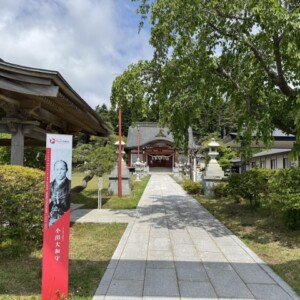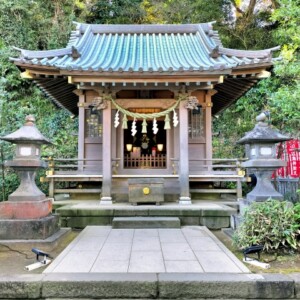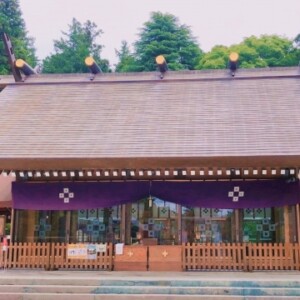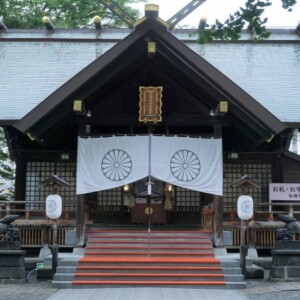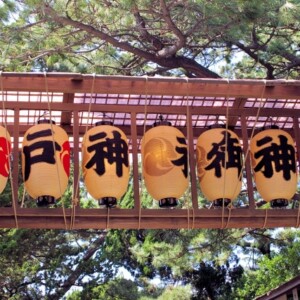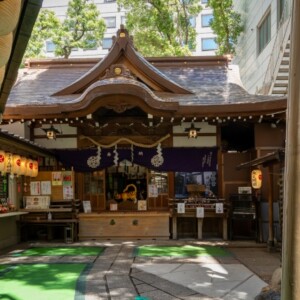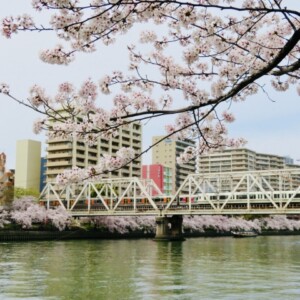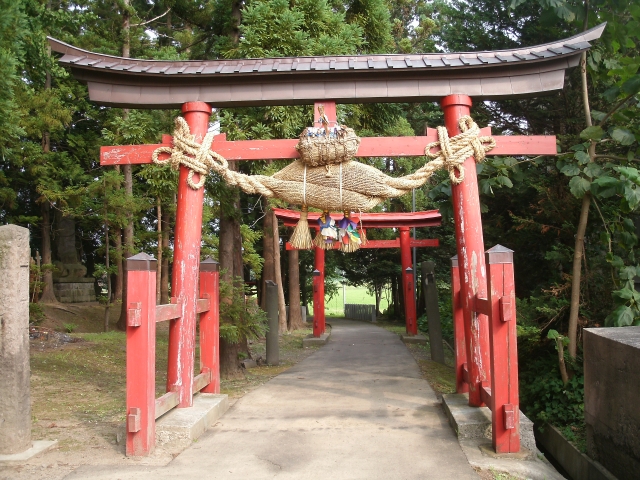
Oni-jinja|A complete guide to the history, highlights, and worship information of this mysterious shrine where the legend of Tsugaru’s demons lives on.
Onigami Shrine, located in the Onizawa district of Hirosaki City, Aomori Prefecture, is a shrine that enshrines an ogre as a deity, which is extremely rare in Japan. Located at the foot of Mount Iwaki, known as Tsugaru Fuji, the shrine has long been loved by local people as a guardian deity of agriculture. The legend of the kind-hearted ogre lives on in this shrine, and a unique culture of warmly welcoming ogres has taken root here, chanting “Fuku wa uchi, oni wa uchi” during the Setsubun holiday.
Outline and basic information about Onigami Shrine
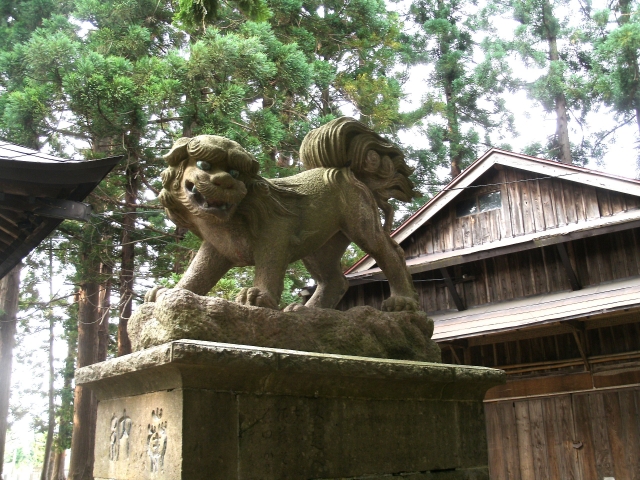
Onigamisha is a shrine built at the northeastern foot of Mt. Iwaki, in the Onizawa district of Hirosaki City, a place named after a legendary demon. The official name of the shrine is “Onigamisha” (鬼神社), but locals call it “Onigamisama” (鬼神さま) in a friendly manner. The most distinctive feature of this shrine is that it enshrines ogres, who are generally feared, as gods that bring blessings.
Oni in the Tsugaru region are seen as god-like beings that combine severity and grace, just like the natural world of mountains and rivers. Even today, they are regarded by local people as precious deities who ward off misfortune and watch over the growth of children. Onigami Shrine was built in 1686 (Jokyo 3) as the central place for the belief in Onigami in Tsugaru.
History and Origin
According to shrine legend, the shrine was founded in the middle of the Enryaku era (782-806), when the barbarian general Sakagami Tamuramaro, during his conquest of the East, rebuilt a shrine at the foot of Mount Iwaki in honor of Takateruhime no Mikoto, who resided in the inner shrine on top of Mount Iwaki. Later, Oyamazuminushi was enshrined at the shrine.
The most famous legend associated with Onigami Shrine is the story of the heartwarming exchange between Yajuro, a young man from Onizawa Village, and the demons of Mount Iwaki. Yajuro met the demon on Mt. Iwaki, wrestled with him, and became friendly with him. When Yajuro told the ogre that his village was suffering from a severe water shortage, the kind-hearted ogre dug an irrigation channel overnight and saved the village from drought. The villagers, in gratitude to the ogre, dedicated the farming tools used by the ogre, such as a chisel and a fork, and this is said to be the origin of the Onigami Shrine.
Gods and Benefits
The deities of Onigamisha are Takateruhime no Mikoto, Izanagi no Okami, and Oyamatsumi no Kami. Takateruhime-no-Mikoto is considered the goddess of Mount Iwaki and is revered in the Tsugaru region.
The main benefit of Onigami Shrine is the protection of agriculture, but it also offers prayers to ward off bad luck, for a bountiful harvest, for children’s growth, and for the longevity of military fortunes. In particular, because of the legend that an ogre saved a village from flooding, the shrine is believed to ward off disasters and give people the power to overcome difficulties. It is also believed that the blessings of the kind-hearted ogre will strengthen bonds between people and bring harmony to the community.
Legend of Oni and Local Culture in Tsugaru
The Tsugaru region has a unique demon culture, and Onigami Shrine is a central part of this culture. The most characteristic custom is that of Setsubun, when people in the Onizawa area do not throw beans but chant “Fuku wa uchi, Oni wa uchi” (Good fortune is within, Oni is also within). This is a custom unique to the area, where people respect demons as benefactors. There is also no custom of putting up a kadomatsu, or decorating irises on the Boys’ Festival.
On the torii (gateway) of some shrines located at the foot of Mount Iwaki, Tsugaru Fuji, there are small, adorable statues of ogres called “oniko” sitting on the ground. These oni-kos are well-known as protectors of the region, and each has a unique appearance in a variety of colors, such as green and light blue. About 10 demon statues are also set up around the Onigami Shrine, delighting the eyes of visitors.
Onijinsha Highlights and Characteristics
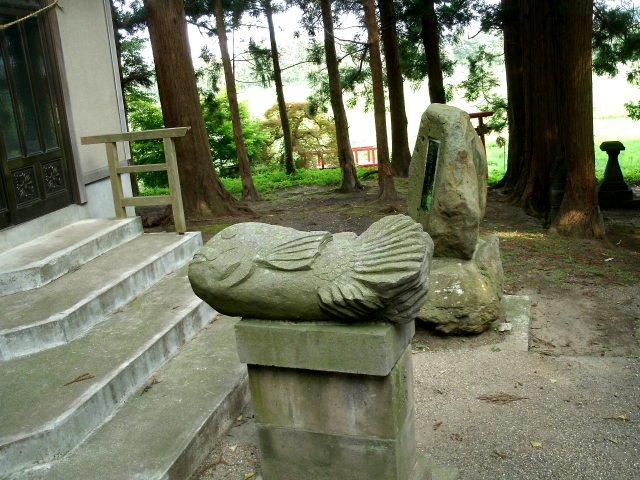
Onigamisha is a shrine with a unique charm that cannot be found anywhere else, reflecting the legend of demons in Tsugaru. Stepping into the shrine grounds, one can feel the deep respect for the existence of demons in the quiet and solemn atmosphere. Interesting elements related to demons can be seen everywhere, from the architecture to every corner of the shrine grounds.
Attractive architecture and structures
At the entrance to the approach to Onigami Shrine stands a magnificent red Otorii gate with a distinctive bale-shaped shimenawa (sacred straw rope), which is common in the Tohoku region. The approach to the shrine is uniquely laid out in such a way that one passes through several red torii gates before reaching the river, where one turns left and makes a U-turn to reach the shrine grounds.
The most striking feature of the torii is that the word “Oni” (ogre) does not have an antler drawn on it. This symbolizes that demons are not an abomination in this area, but are revered as benevolent deities. The main shrine is built in the Nagare-zukuri style, and the “manjiboe” is used as the sacred crest.
In front of the shrine building, there are the usual guardian dogs, but what is particularly unusual is that a pair of guardian fish are enshrined within the precincts of the shrine. Although the origin of this pair of fish is not known, it is an interesting element that expresses the unique character of Onijinsha.
Distinctive landscape of the shrine precincts
The precincts of Onijinsha are 442 tsubo in area, and are kept clean and tidy by the Ujiko (shrine parishioners) in the absence of a resident priest. The shrine grounds are very quiet and, combined with its location at the foot of Mount Iwaki, create a solemn and mystical atmosphere.
Elements symbolizing Tsugaru’s demon culture are placed throughout the temple grounds. Multiple red torii gates located from the approach to the temple to the precincts clearly mark the entrance to the Shinto shrine and guide visitors into the sacred space. A parking lot for approximately 10 cars is located behind the temple grounds for the convenience of visitors.
Cultural Properties and Offerings Related to Oni
The most distinctive attraction at Onigami Shrine is a large iron farming tool dedicated to the shrine. Huge iron tools, such as a saw, chisels, and a saw, which are said to have been used by demons to build irrigation canals, are framed and displayed on the wall, and the power of these tools is overwhelming. These farming implements are valuable cultural assets that testify to the strength of the ogres and their deep love for the villagers.
A 1,000-year-old iron hoe-shaped hoe is also said to be kept in the shrine’s treasures, testifying to the long history of faith in farming tools. Next to the flat plaque in the hall of worship, there is also a large plaque that resembles a large farming tool associated with the legend of demons, allowing visitors to feel the deep connection between demons and agriculture.
A wooden picture of the flat plaque, “Chicken Play Picture Book,” is also kept as a treasure in the shrine. This is a valuable cultural asset that is carefully protected by the shrine parishioners and can be viewed on special occasions. All of these cultural assets were dedicated out of gratitude and devotion to the demons, and are important testaments to the history of Onigami Shrine and the local culture.
Guide to Worship

Worship at Onigami Shrine is conducted in the same manner as at ordinary shrines, but it is important to keep in mind that this is a special shrine that enshrines demons as deities, and to pay your respects. The shrine grounds are carefully maintained by the Ujiko (shrine parishioners), allowing visitors to pray wholeheartedly in a tranquil environment.
Worship Etiquette and Manners
Worship at Onigami Shrine is conducted in accordance with general shrine etiquette. First, bow at the Otorii gate at the entrance to the approach to the shrine, and then head toward the shrine grounds, avoiding the center of the approach. If there is a water fountain, purify your hands and mouth, and then pray in front of the hall of worship in the manner of two hands, two beats, and one bow.
One of the unique characteristics of Onigami Shrine is that it is important to express gratitude to the demons when worshipping. The demons of this shrine are the benefactors who saved the villagers and are believed to be the guardian gods of agriculture. When visiting the shrine, it is advisable to express gratitude for the blessings of nature and daily sustenance, and to wish for the strength to overcome difficulties.
Visitors are advised to maintain silence in the precincts of the shrine and to refrain from loud conversations. In addition, the farming tools dedicated to the shrine are valuable cultural assets, so care should be taken when taking pictures, following the rules of the shrine and avoiding the use of flash.
Annual and Seasonal Events
Shinto rituals are conducted according to the lunar calendar at Onigami Shrine, and many events are held throughout the year. The most famous is the “Onigamisha Shime-nawa Shime-nawa Dedication Naked Prayer” held on January 1 of the lunar calendar, popularly known as “Onizawa no Hadaka mairi” (Onizawa’s Naked Prayer). In this ritual, participants purify themselves by bathing in a large barrel of cold water in front of the Otorii gate to pray for the exorcism of bad luck and a good harvest.
On January 29th of the lunar calendar, the “Shichinichido Festival” (29th day of the year) is held. This festival was designated as an Aomori Prefecture Intangible Folk Cultural Asset on April 13, 2022, and is known as “Tsugaru’s Nanakkido Festival” along with Iwakisan Shrine in Hirosaki City and Saruga Shrine in Hirakawa City. In the festival, the “Glorious Seal” event is used to drive away evil spirits, and the “Goshinbi”, “Goyanagi”, “Sambaiko”, and “Early Rice, Middle Rice, and Late Rice” events are used to comprehensively determine the crop and weather conditions for the year.
Yoimiya, the Grand Festival, and the regular festival are also held according to the lunar calendar. During Yoimiya, approximately 20 stalls are set up and crowded with local people. In addition, garlic is sometimes sold in limited quantities. It is said that demons from all over Japan gather at the Onigami Shrine during Setsubun, and a unique custom continues in the community of welcoming the demons with the chant “Fuku wa uchi, oni mo uchi.
Red Seal and Good Luck Charm Information
Onijinsha offers special charms associated with demons, and the “Oni ni Kinbou” amulet is particularly popular. This amulet expresses the feeling of fearlessness and invincibility, and is said to bring blessings such as the power to face difficulties and longevity of military fortune. It is so popular that it is sometimes sold out.
Other items on sale include demon ema (votive tablet), various amulets with demon motifs, and “oni ni kanabou” (demon with a metal rod) straps. These items are often sold during special events such as Yoimiya, so it is recommended to check in advance if you wish to purchase them.
Goshuin (red seals) are administered by Ujiko (shrine parishioners), as the shrine is not staffed by a chief priest. For information on the granting of red seals, it is advisable to inquire in advance or check at the time of a festival. For more information, please contact the Onizawa Information Center.
Access/Use Information
Onigami Shrine is located on the outskirts of Hirosaki City, Aomori Prefecture, at the foot of Mount Iwaki, approximately 30 minutes by car from Hirosaki Station. It is accessible by both public transportation and personal car; however, it is recommended to check the bus schedule in advance due to the limited number of buses.
Transportation Access
By public transportation, take the Ajigasawa or Dogasawa line of the Konan Bus from JR Hirosaki Station, and you will arrive at the “Onizawa” bus stop in about 40 minutes. From the bus stop, it is approximately a 5-minute walk to Onigamisha Shrine. Since the bus service is limited, it is important to check the timetable of the Konan Bus in advance, as well as the time of the return bus.
If you drive your own car, it takes about 30 minutes from JR Hirosaki Station. From downtown Hirosaki, head toward Mt. Iwaki, and follow the prefectural road toward Ajigasawa Town. When using a car navigation system, please set “151 Shobuzawa, Onizawa, Hirosaki-shi, Aomori” as your destination.
The nearest railroad station is Itayanagi Station on the JR Gono Line (about 5 km to the east). The Naranoki bus stop can be reached in about 6 minutes on foot.
Hours of worship, fees, and parking information
Onigamisha is basically open for worship 24 hours a day, but the shrine office and the awarding of red seals and amulets are available only during limited hours. Please contact the Onisawa Information Center (0172-98-2141) in advance for more detailed information.
There is no charge to visit the shrine. However, you can help maintain the shrine by paying a dedication fee or monetary offering during special festivals. Fees are set individually for each of the gifts, such as amulets and ema (votive picture tablet).
Parking for approximately 10 vehicles is available behind the shrine and is free of charge. If you plan to visit the shrine with a large bus, we recommend that you check the parking space in advance. The parking lot may not be paved, so please be careful with your footing during rainy or snowy seasons.
Other tourist attractions in the area include the “Oni no Dorogyo,” where demons are said to have wrestled, which can be toured on foot. Tours of the legend of the demons of Tsugaru are also held regularly, and visitors can tour the Onizawa area while listening to a detailed explanation by a local guide.
<Address> 151 Shobuzawa, Onizawa, Hirosaki City, Aomori Prefecture, 036-1205, Japan
Reference site
Old Tsugaru Home Page: https://kotsugaru.com/
Hirosaki City Official Tourist Information: https://www.hirosaki-kanko.or.jp/
Travel Tohoku (Tohoku Tourism Promotion Organization): https: //www.tohokukanko.jp/



